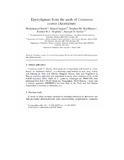| dc.contributor.author | Shoeb, M. | |
| dc.contributor.author | Jaspars, M. | |
| dc.contributor.author | MacManus, S.M. | |
| dc.contributor.author | Majinda, R.R.T. | |
| dc.contributor.author | Sarker, S.D. | |
| dc.date.accessioned | 2009-03-25T14:12:36Z | |
| dc.date.available | 2009-03-25T14:12:36Z | |
| dc.date.issued | 2004 | |
| dc.identifier.citation | Shoeb, M. et al (2004) Epoxylignans from the seeds of Centaurea cyanus (Asteraceae), Biochemical Systematics and Ecology, vol. 32, pp. 1201–1204 | en |
| dc.identifier.issn | 0305-1978 | |
| dc.identifier.uri | http://hdl.handle.net/10311/300 | |
| dc.description.abstract | A study focusing on Centaurea cyanus L. (family: Asteraceae alt. Compositae), otherwise known as "cornflower" or "bachelor's button. The seed is purchased from B & T World Seeds sarl, Pauguignan, 34210 Olonzac, France and the voucher specimen (PHSH0002) kept in the Plant and Soil Science Department, University of Aberdeen, UK for testing. The result shows the occurrence of epoxylignans, berchemol
(1) and lariciresinol 4-O-b-d-glucopyranoside (2) in the seeds of C. cyanus. | en |
| dc.language.iso | en | en |
| dc.publisher | Elsevier Ltd. www.elsevier.com/locate/biochemsyseco | en |
| dc.subject | Centaurea cyanus | en |
| dc.subject | Asteraceae | en |
| dc.subject | Epoxylignan | en |
| dc.subject | Berchemol | en |
| dc.subject | Lariciresinol 4'-O-b-d-glucopyrano side | en |
| dc.subject | Chemotaxonomy | en |
| dc.title | Epoxylignans from the seeds of Centaurea cyanus (Asteraceae) | en |
| dc.type | Published Article | en |

